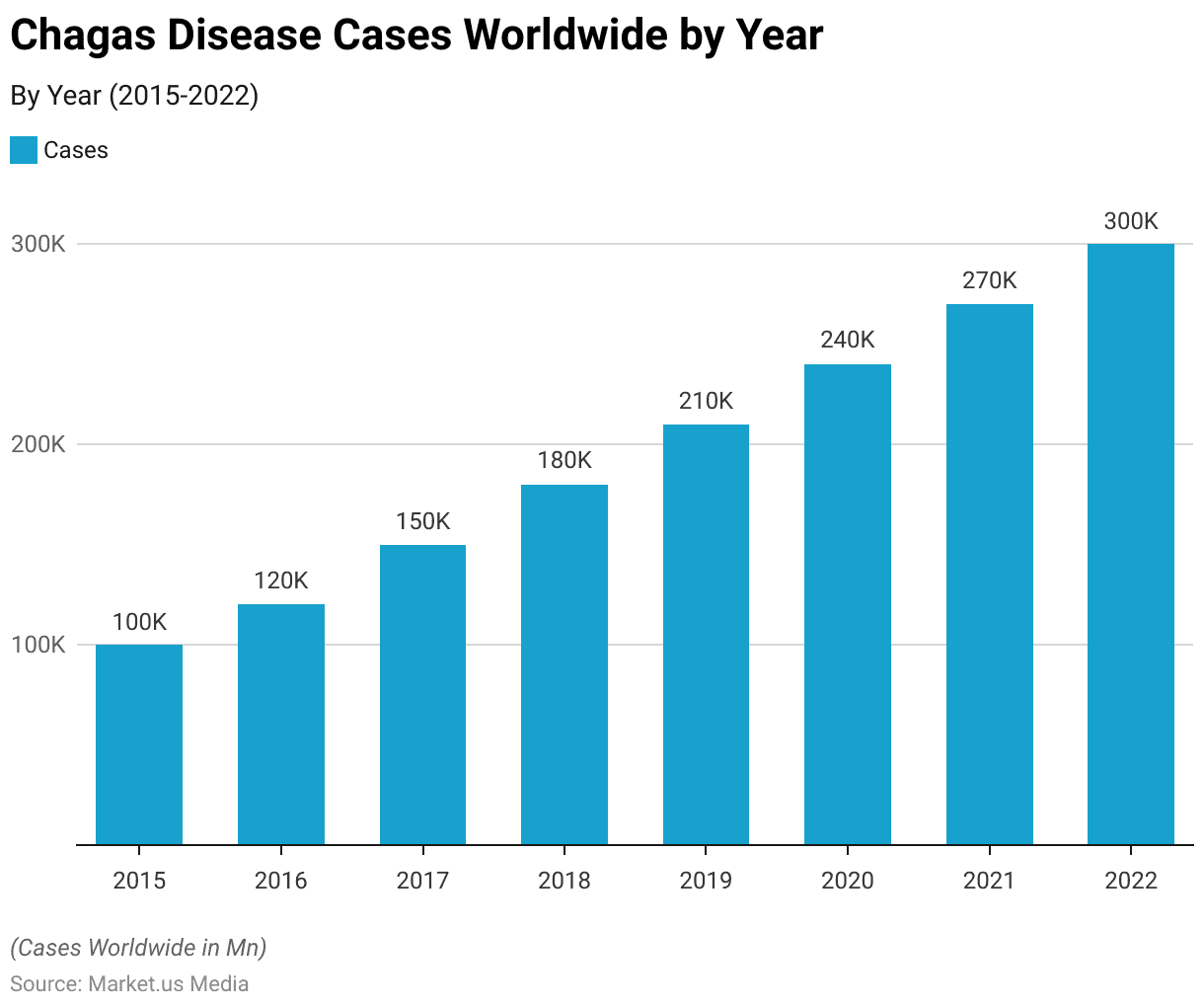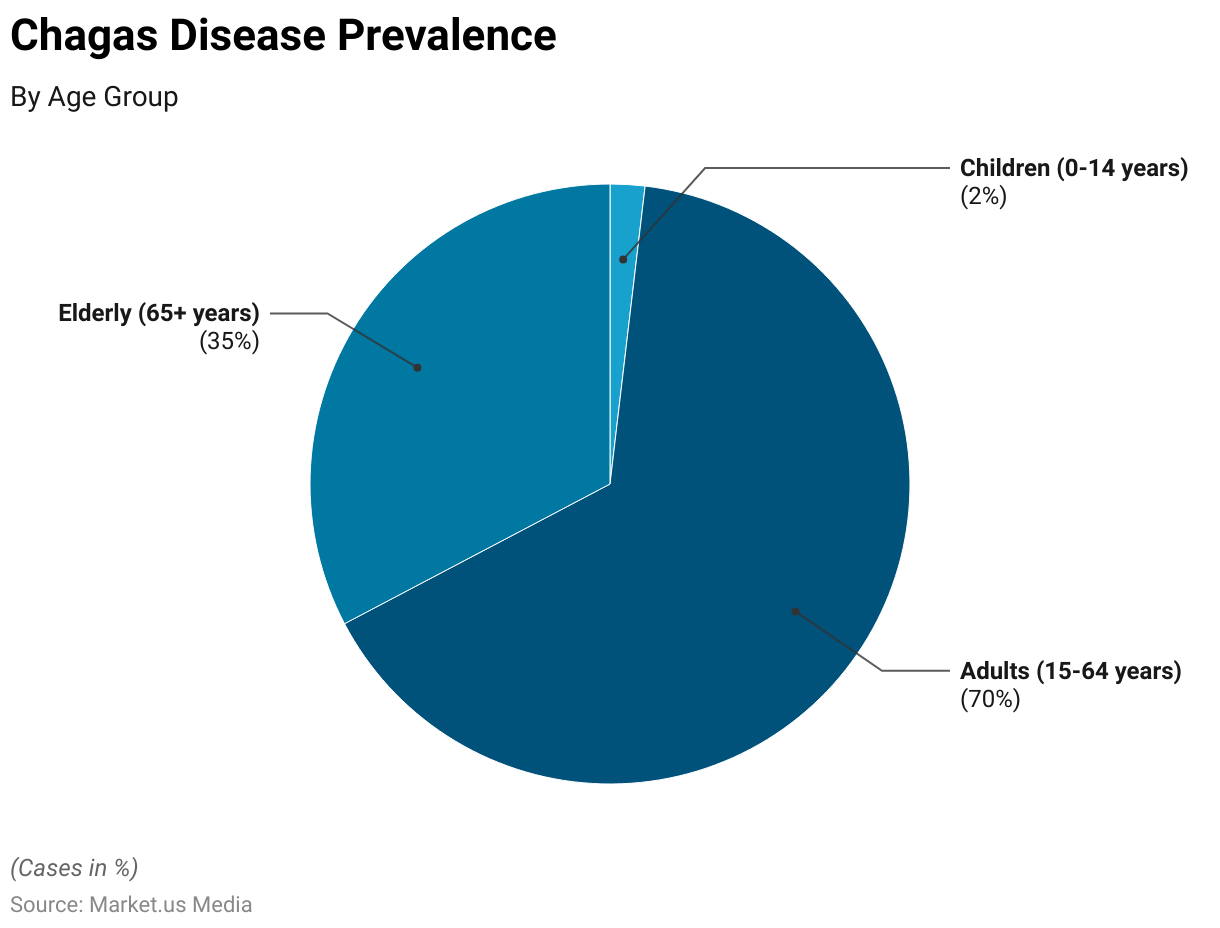According to Chagas Disease Statistics, Chagas disease, caused by the Trypanosoma cruzi parasite, stands as one of Latin America’s most significant and persistent public health challenges. Spread primarily by triatomine bugs, the disease affects an estimated 6-7 million individuals worldwide.
While traditionally confined to regions of Latin America, globalization and migration patterns have led to an increasing number of cases in non-endemic countries.
Despite the vast number of individuals affected, Chagas disease remains under-diagnosed and under-reported, with many unaware of their infection until its advanced stages.
The urgency to address this ailment continues to grow, especially given the limited treatment options and its profound socio-economic implications.
Table of Contents
Editor’s Choice
- The Insect Repellent Market is expected to expand at a CAGR of 6.93%.
- Global Cases: An estimated 6-7 million people are affected by Chagas disease worldwide.
- Endemic Countries: Chagas disease is endemic in 21 Latin American countries, although cases have been reported in other continents due to migration.
- Vector Spread: Over 70 species of triatomine bugs are known to transmit the Trypanosoma cruzi parasite, the causative agent of disease.
- Mortality Rate: Approximately 12,000 deaths occur annually due to disease-related complications.
- Undiagnosed Cases: Up to 70% of people infected with Chagas disease might not know they have it, as symptoms can be mild or non-existent in the early stages.
- Transmission Modes: Besides triatomine bug bites, Chagas can be transmitted via blood transfusion, organ transplantation, congenitally, and in rare cases, through consumption of contaminated food.
- Treatment Challenge: Only two drugs, benznidazole, and nifurtimox, are available for treatment, and they are most effective in the early stages of the disease.

Transmission Modes and the Role of Triatomine Bugs in Chagas Disease
- Triatomine Bugs: Over 140 triatomine species are recognized, but only a few are key vectors in transmitting the disease.
- Main Mode of Transmission: About 70-80% of disease cases are transmitted through the bite of an infected triatomine bug.
- Blood Transfusion: Before widespread screening was implemented, the disease was often transmitted through contaminated blood transfusions. Today, most blood banks in endemic areas screen for the disease, reducing this risk.
- Congenital Transmission: Between 1-10% of newborns from infected mothers can contract the disease during childbirth.
- Other Modes: In rare cases, Chagas can spread through organ transplantation, consumption of contaminated food or drink, or laboratory accidents.
- Distribution: While triatomine bugs are found in 21 Latin American countries, Chagas disease cases due to migration are now reported worldwide, including in the USA, Canada, and some European countries.
- Housing and Vector: Poor housing conditions, especially mud walls, and thatched roofs, increase the likelihood of homes being infested by triatomine bugs.
Chagas Disease Statistics by Age Group
Children (0-14 years)
- Children in endemic areas have a higher risk of acquiring Chagas disease via congenital transmission. About 5% of babies born to infected mothers will have the disease.
- In areas with active transmission, around 1-2% of children under 15 years may be infected.
Adults (15-64 years)
- Adults account for a substantial proportion of Chagas cases due to the chronic nature of the disease. By adulthood, nearly 30-40% of those infected in childhood could develop serious cardiac or digestive complications.
- Vector control has reduced the incidence in adults in many areas, but many remain undiagnosed due to the disease’s asymptomatic nature in its early stages.
Elderly (65+ years)
- Older adults are more likely to experience complications if infected earlier in life. It’s estimated that 20-30% of chronically infected individuals will suffer from cardiac alterations and up to 10% will have digestive, neurological, or mixed alterations which might become more pronounced with age.

Economic Impact of Chagas Disease
- Lost Productivity: Chagas disease causes an estimated loss of 500,000 to 1.2 million disability-adjusted life years (DALYs) annually.
- Treatment Costs: The direct medical cost for treating an individual in the acute phase is roughly $300, while treatment during the chronic phase can exceed $3,000.
- Cost to Health Systems: In Latin America, the direct annual healthcare costs of the disease are estimated to be around $500 million.
- Lost Earnings: Patients with disease can lose up to 10% of their lifetime earnings due to premature death or inability to work.
- Impact on GDP: Countries highly endemic to disease can experience up to a 0.5% decrease in their annual GDP due to healthcare costs and lost productivity.
- Transfusion Screening Costs: Non-endemic countries can spend up to $10 million annually on screening blood donations for disease to prevent transmission.
- Vector Control Programs: Investments in vector control and housing improvements to combat Chagas disease cost around $10-$25 per person protected in Latin America.
Control and Prevention of Chagas Disease
- Insecticide Spraying: Around 80% reduction in household infestation by triatomine bugs has been achieved in some endemic areas through large-scale insecticide spraying campaigns.
- Blood Screening: Over 90% of blood donations are screened for Chagas disease in Latin America, significantly reducing the risk of transmission through transfusions.
- Oral Transmission: Outbreaks of oral transmission have been reduced by over 70% in some areas through public health interventions, such as improved food hygiene practices.
- New Infections: Since the 1990s, control initiatives have prevented more than 70% of potential new Chagas disease cases in endemic countries.
- Congenital Transmission: Programs targeting congenital transmission have achieved a 50% reduction in neonatal cases in several countries through improved prenatal screening and treatment.
- Vector Surveillance: Continuous surveillance has led to a 60% decrease in vector re-infestations in previously cleared areas.
Chagas Disease Statistics by Country
Bolivia
- Prevalence: Approximately 6.1% of the population is affected by Chagas disease.
- Vector Control: Around 65% of infested households have been treated to reduce triatomine bug transmission.
- Diagnosis: Only about 7% of infected individuals are aware of their condition.
- Congenital Transmission: Disease is passed from mother to child in about 5% of cases.
- Mortality: Chagas-related deaths account for about 6% of overall deaths in Bolivia.
- Treatment: Only 1% of those needing treatment receive it due to limited access and resources.
Paraguay
- Prevalence: Chagas disease affects around 3.5% of the population.
- Vector Control: Approximately 60% of infested houses have been treated to control the spread.
- Rural-Urban Divide: Prevalence is higher in rural areas, with rates up to 5% compared to around 2% in urban areas.
- Chagas-Related Cardiomyopathy: About 30% of infected individuals develop cardiac issues due to the disease.
- Blood Donor Screening: Blood donation screening has reduced transmission, with infected donations decreasing to around 0.2%.
- Awareness: Roughly 12% of those with Chagas disease in Paraguay are aware of their condition.
El Salvador
- Prevalence: Chagas disease affects approximately 1.6% of the population.
- Vector Control: Nearly 60% of infested households have been treated to reduce transmission.
- Disease Transmission: Around 94% of cases are transmitted through vector contact.
- Acute Cases: Only about 2% of infected individuals develop acute symptoms.
- Early Detection: Limited access to healthcare results in delayed diagnosis, with only 1.6% of cases detected early.
- Treatment Gap: Less than 1% of those requiring treatment for disease receive it.
Honduras
- Prevalence: Approximately 2.5% of the population is affected by Chagas disease.
- Vector Control: About 40% of infested households have been treated to reduce transmission.
- Pediatric Infections: Congenital transmission accounts for about 2.7% of new infections in children.
- Barriers to Treatment: Limited healthcare access results in only 0.7% of those needing treatment receiving it.
- Chagas-Related Deaths: Disease contributes to around 4.5% of overall deaths in Honduras.
- Disease Awareness: Approximately 10% of Chagas cases are diagnosed and known to patients.
Guatemala
- Prevalence: Chagas disease affects approximately 1.6% of the population.
- Vector Control: Around 55% of infested households have been treated to control transmission.
- Rural Impact: Prevalence is higher in rural areas, with rates up to 3.2% compared to around 0.7% in urban areas.
- Pediatric Infections: Congenital transmission accounts for about 2.5% of new infections in children.
- Chagas-Related Cardiomyopathy: Around 25% of infected individuals develop cardiac complications.
- Treatment Access: Less than 1% of those needing treatment for Chagas disease have access to it.
Discuss your needs with our analyst
Please share your requirements with more details so our analyst can check if they can solve your problem(s)



